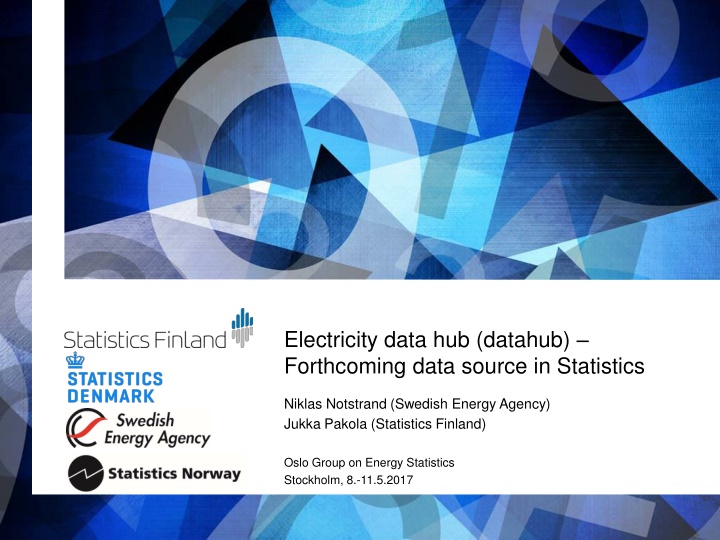
Electricity Data Hub and Potential Energy Statistics Sources
"Explore the concept of an Electricity Data Hub as a central information exchange system for the electricity retail market, providing potential data sources for energy and other statistics. Discover how readings from electricity metering points by customer and meter can enhance quality information across various sectors and industries."
Download Presentation

Please find below an Image/Link to download the presentation.
The content on the website is provided AS IS for your information and personal use only. It may not be sold, licensed, or shared on other websites without obtaining consent from the author. If you encounter any issues during the download, it is possible that the publisher has removed the file from their server.
You are allowed to download the files provided on this website for personal or commercial use, subject to the condition that they are used lawfully. All files are the property of their respective owners.
The content on the website is provided AS IS for your information and personal use only. It may not be sold, licensed, or shared on other websites without obtaining consent from the author.
E N D
Presentation Transcript
Electricity data hub (datahub) Forthcoming data source in Statistics Niklas Notstrand (Swedish Energy Agency) Jukka Pakola (Statistics Finland) Oslo Group on Energy Statistics Stockholm, 8.-11.5.2017
Contents What is an Electricity data hub? Main data content Potential data source for Energy and Other Statistics Quality Assurance Next steps 2 12 April 2025 Etunimi Sukunimi
What is an Electricity data hub (datahub)? Datahub is a centralized information exchange system for the electricity retail market, which will contain data from electricity metering points. Used by electricity suppliers and distribution network companies serving electricity consumers. All parties with equal access to the information. The information is available to third parties, e.g. reporting to authorities given legislation and confidentiality regarding micro-data. 3 12 April 2025 Etunimi Sukunimi
Data content Readings from electricity metering points by customer and meter. Frequency: hourly to annual. In the future: hourly, 15 min(?). Unique identifiers for persons and enterprises. Location information, group of classifiers (like industry code, consumer type) Coverage: entire electricity retail market. Including non-market, market sector units and households. About 3 million meters per country. Does not include electricity price information. Includes, at least in Finland, the information on distribution tariff. 4 12 April 2025 Etunimi Sukunimi
Potential data source for Energy statistics All Energy statistics regarding especially to the use of electricity potentially benefit. E.g. Electricity statistics (monthly and annual), Energy use in the manufacturing sector. Better quality information by sector and/or industry activity, or by consumer group. Even the annual figures almost in real-time from the datahub In the future: small-scale electricity production (like solar power) figures. The goal is to have also capacity information by meter. 5 12 April 2025 Etunimi Sukunimi
Potential data source for other statistics Statistical Business Register. Update unit structure by updating e.g. new construction sites. Indirect source to find potential errors in NACE. Households consumption. Electricity consumption per apartment (household) can be used as a source to calculate the expenditure on electricity. Dwellings and housing. Matching metering point location and use of electricity to addresses could give an indication of where people live. 6 12 April 2025 Etunimi Sukunimi
Quality Assurance Accuracy and Reliability. Improve e,g. the accuracy of the breakdown on sectors. Note: The measuring errors ? Timeliness and Punctuality. Almost real-time data. Coherence and Comparability. Dimishing the gap consumption vs generation. The coherence will improve over time and countries. Non-excessive Burden on Respondents. Less surveys. Note: Identifiers and the location information not yet good enough. The inconsistency of addresses between datahub and the statistical registers and the multiple meters within one location having many enterprises will persist (to some extent). 7 12 April 2025 Etunimi Sukunimi
Next steps Statistics Denmark is planning to implement data in the validation process of energy statistics in spring 2017. Statistics Norway is planning to produce the monthly electricity statistics by using the datahub data in the 4th quarter of 2017. Discussions about having pilot data, data transmission technique, etc. will begin later in Finland and Sweden. 8 12 April 2025 Etunimi Sukunimi
Thank You! Questions? Comments?
